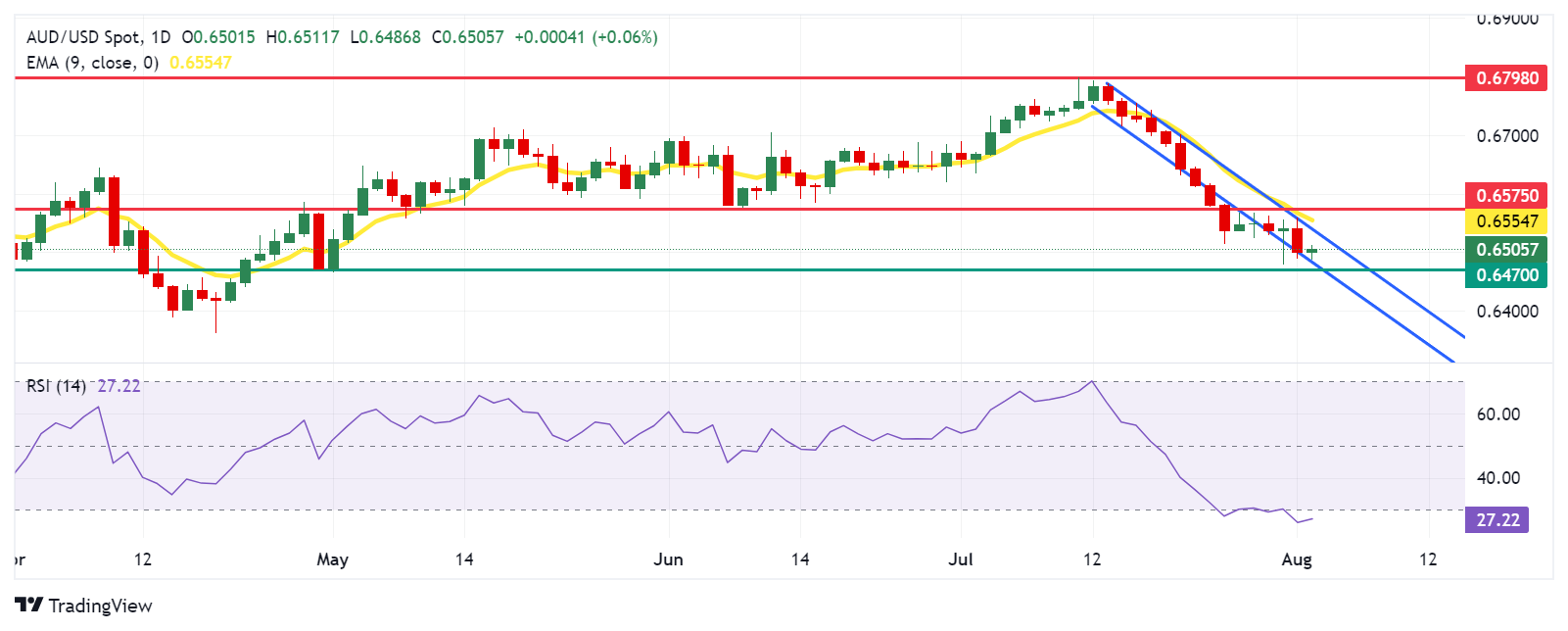- The Australian dollar is gaining strength following the release of higher Producer Price Index figures.
- Australia’s PPI rose 4.8% year-on-year in the second quarter, up from the previous quarter’s reading of 4.3%.
- The US Dollar received support from rising risk aversion amid growing concerns about the US economy.
The Australian Dollar (AUD) is recovering its daily losses against the US Dollar (US) following higher Producer Price Index (PPI) data released on Friday. However, this momentum could be limited due to rising risk aversion ahead of upcoming US labor market data, including the Non-Farm Payrolls report for July.
The Australian Dollar is facing challenges as second quarter inflation data has dampened expectations of another rate hike by the Reserve Bank of Australia (RBA) at its monetary policy meeting next week. Markets are now pricing in a roughly 50% chance of an RBA rate cut in November, a move anticipated much earlier than previously anticipated in April next year. These factors are contributing to the downward pressure on the Australian Dollar.
Recent manufacturing and employment data have heightened concerns about the US economy, boosting risk aversion and supporting the US dollar. Markets are grappling with a delicate balance as an economic slowdown raises expectations for a rate cut by the Federal Reserve. The CME’s FedWatch tool indicates that traders are fully pricing in a 25 basis point rate cut on September 18, with a one in five chance of a 50 basis point cut.
Daily Market Wrap: Australian Dollar Advances Following PPI Data
- The US ISM manufacturing Purchasing Managers’ Index (PMI) fell to an eight-month low of 46.8 in July, compared with the previous reading of 48.5 and a forecast for a rise to 48.8.
- US initial jobless claims for the week ending July 26 rose to 249K from 235K the previous week, beating forecasts for an increase to 236K.
- China’s Caixin Manufacturing Purchasing Managers’ Index (PMI) recorded a reading of 49.8 for July, below the expected reading of 51.5 and the previous reading of 51.8. Since both nations are close trading partners, changes in the Chinese economy can significantly impact the Australian market.
- The Australian Bureau of Statistics (ABS) reported a trade surplus of 5.589 billion for June, exceeding the 5 billion forecast but still below the previous reading of 5.773 billion.
- During a press conference, Federal Reserve Chairman Jerome Powell said a rate cut in September is “on the table.” Powell added that the central bank will closely monitor the labor market and remain vigilant for possible signs of a sharp slowdown, according to Reuters.
- The ABS reported on Wednesday that monthly CPI rose 3.8% in the year to June, slowing from 4% in May. Quarterly CPI rose 1% quarter-on-quarter and 3.8% year-on-year in the second quarter of the year. The RBA’s cut CPI, the central bank’s preferred indicator, rose 3.9% year-on-year in the second quarter, versus the expected and previous reading of 4.0%.
Technical Analysis: Australian Dollar Holds Its Position Around 0.6500
The Australian Dollar is trading around 0.6510 on Friday. The daily chart analysis shows that the AUD/USD pair is consolidating within a descending channel, which indicates a bearish bias. The 14-day Relative Strength Index (RSI) is near the oversold level of 30, suggesting that a potential upward correction could be imminent.
Immediate support for the AUD/USD pair is around the lower boundary of the descending channel at 0.6470, followed by retracement support at around 0.6470.
On the upside, the upper boundary of the descending channel at 0.6530 serves as an immediate resistance, followed by the nine-day exponential moving average (EMA) at 0.6555. The next barrier for the AUD/USD pair appears at the “retracement support turned resistance” at 0.6575. A break above this resistance could lead the AUD/USD pair towards a six-month high of 0.6798.
AUD/USD: Daily Chart
Australian Dollar PRICE Today
The table below shows the Australian Dollar (AUD) exchange rate against major currencies today. The Australian Dollar was the strongest currency against the British Pound.
| USD | EUR | GBP | JPY | CAD | AUD | NZD | CHF | |
|---|---|---|---|---|---|---|---|---|
| USD | 0.03% | 0.17% | 0.06% | -0.01% | -0.03% | 0.11% | -0.02% | |
| EUR | -0.03% | 0.13% | 0.03% | -0.05% | -0.06% | 0.06% | -0.05% | |
| GBP | -0.17% | -0.13% | -0.11% | -0.18% | -0.20% | -0.06% | -0.16% | |
| JPY | -0.06% | -0.03% | 0.11% | -0.06% | -0.09% | 0.02% | -0.07% | |
| CAD | 0.01% | 0.05% | 0.18% | 0.06% | -0.02% | 0.13% | 0.01% | |
| AUD | 0.03% | 0.06% | 0.20% | 0.09% | 0.02% | 0.14% | 0.02% | |
| NZD | -0.11% | -0.06% | 0.06% | -0.02% | -0.13% | -0.14% | -0.09% | |
| CHF | 0.02% | 0.05% | 0.16% | 0.07% | -0.01% | -0.02% | 0.09% |
The heatmap shows percentage changes of major currencies. The base currency is selected from the left column, while the quote currency is selected from the top row. For example, if you choose the Australian Dollar from the left column and move along the horizontal line to the US Dollar, the percentage change shown in the chart will represent the AUD (base)/USD (quote).
Australian Dollar FAQs
One of the most important factors for the Australian Dollar (AUD) is the level of interest rates set by the Reserve Bank of Australia (RBA). Since Australia is a resource-rich country, another key factor is the price of its largest export, iron ore. The health of the Chinese economy, its largest trading partner, is a factor, as is inflation in Australia, its growth rate and the Trade Balance. Market sentiment, i.e. whether investors are betting on riskier assets (risk-on) or seeking safe havens (risk-off), is also a factor, with risk-on being positive for the AUD.
The Reserve Bank of Australia (RBA) influences the Australian Dollar (AUD) by setting the level of interest rates that Australian banks can lend to each other. This influences the level of interest rates in the economy as a whole. The RBA’s main objective is to maintain a stable inflation rate of 2%-3% by adjusting interest rates up or down. Relatively high interest rates compared to other major central banks support the AUD, and the opposite for relatively low ones. The RBA can also use quantitative easing and tightening to influence credit conditions, with the former being negative for the AUD and the latter positive for the AUD.
China is Australia’s largest trading partner, so the health of the Chinese economy greatly influences the value of the Australian Dollar (AUD). When the Chinese economy is doing well, it buys more raw materials, goods and services from Australia, which increases demand for the AUD and drives up its value. The opposite occurs when the Chinese economy is not growing as fast as expected. Therefore, positive or negative surprises in Chinese growth data often have a direct impact on the Australian Dollar.
Iron ore is Australia’s largest export, worth $118 billion per year as of 2021 data, with China being its main destination. The price of iron ore can therefore be a driver of the Australian dollar. Typically, if the price of iron ore rises, the AUD rises as well, as aggregate demand for the currency increases. The opposite occurs when the price of iron ore falls. Higher iron ore prices also tend to lead to a higher probability of a positive trade balance for Australia, which is also positive for the AUD.
The trade balance, which is the difference between what a country earns from its exports and what it pays for its imports, is another factor that can influence the value of the Australian dollar. If Australia produces highly sought-after exports, its currency will gain value solely because of the excess demand created by foreign buyers wanting to purchase its exports versus what it spends on buying imports. Therefore, a positive net trade balance strengthens the AUD, with the opposite effect if the trade balance is negative.
Source: Fx Street
I am Joshua Winder, a senior-level journalist and editor at World Stock Market. I specialize in covering news related to the stock market and economic trends. With more than 8 years of experience in this field, I have become an expert in financial reporting.






